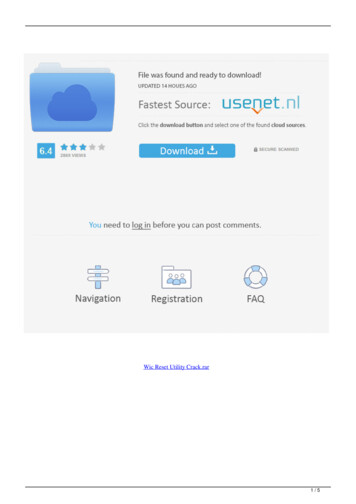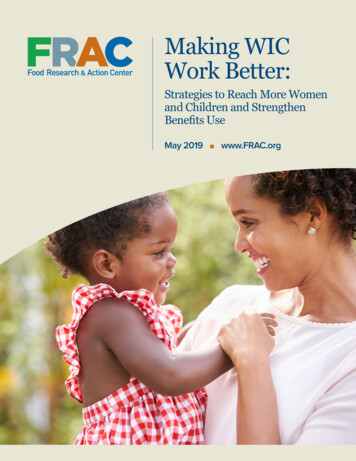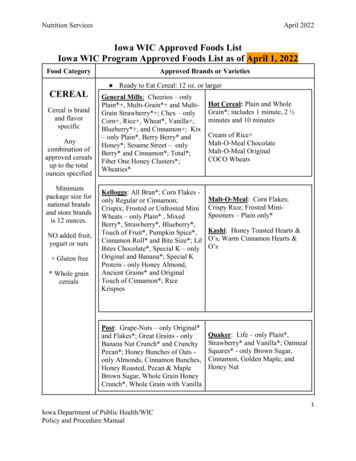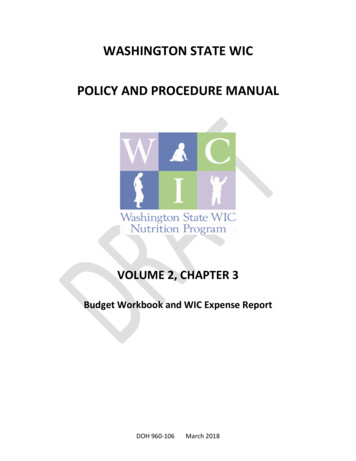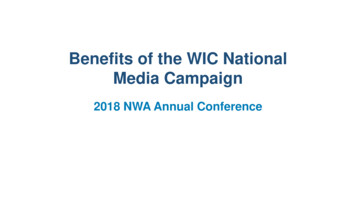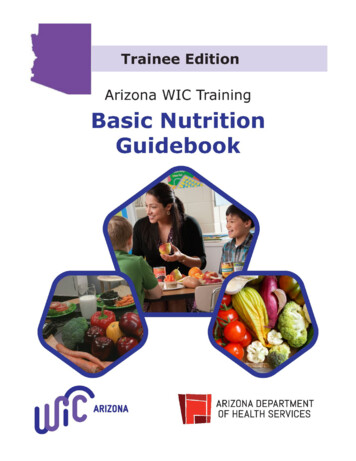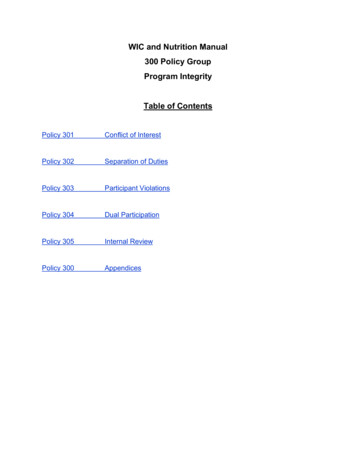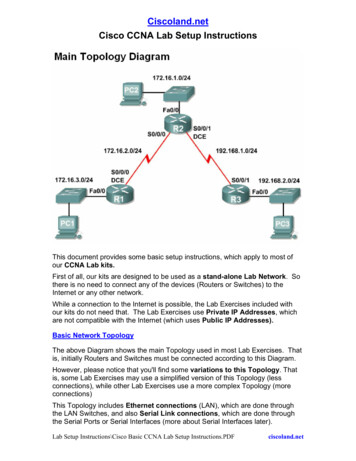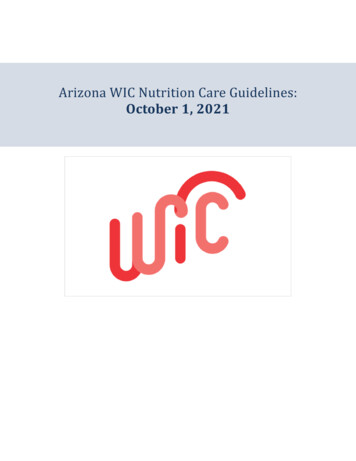
Transcription
Arizona WIC Nutrition Care Guidelines:October 1, 2021
This page intentionally left blank.
Arizona WIC Nutrition Care Guidelines: Table of ContentsTable of ContentsIntroduction to Nutrition Care Guidelines .5Section I. Infants .11A - Anthropometric Assessment.13B - Biochemical Assessment .18C - Clinical Assessment .21D - Dietary Assessment.26E - Environmental Assessment .40Take Home Messages .43References .44Section II. Children (Ages 1 Through 4 Years) .45A - Anthropometric Assessment.47B - Biochemical Assessment .52C - Clinical Assessment .55D - Dietary Assessment.60E - Environmental Assessment .68Take Home Messages .71References .72Section III. Pregnant Women .73A - Anthropometric Assessment.75B - Biochemical Assessment .78C - Clinical Assessment .81D - Dietary Assessment.91E - Environmental Assessment .98Take Home Messages .101References .102Section IV. Breastfeeding and Postpartum Women .103A - Anthropometric Assessment.105B - Biochemical Assessment .108C - Clinical Assessment .110D - Dietary Assessment.119E - Environmental Assessment .124Take Home Messages .127References .128
This page intentionally left blank.
Arizona WIC Nutrition Care Guidelines:Introduction
This page intentionally left blank.
Arizona WIC Nutrition Care Guidelines: IntroductionIntroduction to Nutrition Care GuidelinesThe Arizona WIC Nutrition Care Guidelines serve as a compilation of nutrition assessment considerationsand basic education prompts to support the delivery of quality nutrition care in WIC. The Nutrition CareGuidelines are not intended to standardize nutrition counseling for each participant, but to ensure thatnutrition counseling in WIC is consistent with national guidelines. In alignment with participant-centeredservices (PCS), WIC is most effective when participants are recognized as the experts about their owncircumstances, and that WIC is a resource to help participants apply the principles of nutrition in aneffective way.Nutrition care is provided in the context of participants’ environmental and educational limitations, theirinterests, and their cultural preferences, with consideration for their progress through the stages ofchange. Stages of change are the cycles that people go through to decide whether they want to changeand what the change will mean to them. Behavioral change doesn’t occur in one step; it progressesthrough several steps or stages. The formal stages of change model identifies the following stages:precontemplation, contemplation, preparation, action, and maintenance. The Nutrition Care Guidelinesact as a reference for WIC staff when offering nutrition education that may be of interest to WICparticipants with relevance to the specific WIC category and risk.The Nutrition Care Guidelines are not intended to replace or duplicate any of the content of newemployee training or the in-depth training and resources that accompany the required week-longbreastfeeding training for all Arizona WIC staff. Though the Nutrition Care Guidelines will provide abroad overview of breastfeeding guidelines in the sections about infants and breastfeeding women, theguidelines cross-reference the Breastfeeding Answers Made Simple textbook for detailed information.The Nutrition Care Guidelines align with USDA guidelines, the American Academy of Pediatrics (AAP)guidelines, and the Academy of Nutrition and Dietetics (AND) Nutrition Care Process (NCP) practiceguidelines within the Nutrition Care Manual (NCM). The NCP consists of four steps: assessment,diagnosis, intervention, and monitoring and evaluation.Step 1: Nutrition Assessment.The USDA WIC Nutrition Services Standards require that staff perform a comprehensive nutritionassessment using the Value Enhanced Nutrition Assessment (VENA) process to provide high-qualitynutrition services in a participant-centered framework and to determine program eligibility. Inaddition, comprehensive nutrition assessments will be done at mid-certification assessments, whenthere is a change in the amount of infant formula being requested, or when a breast pump is beingissued. The Academy of Nutrition and Dietetics defines nutrition assessment as a systematic methodfor obtaining, verifying, and interpreting data needed to identify nutrition-related problems, theircauses, and their significance. Nutrition assessment is an ongoing process that involves both initialdata collection and continued reassessment and analysis of participants’ nutrition status. ArizonaWIC utilizes the conversational approach to assessment and completes the nutrition assessment byusing the ABCDE assessment guide, which coordinates with the WIC codes.IntroductionPage 710/01/2021
Arizona WIC Nutrition Care Guidelines: IntroductionA - is gathering anthropometric information, or height and weight, from the participant andincludes WIC codes in the 100s.B - is gathering biochemical information—specifically, screening for risk of anemia and highblood lead concentrations—and includes WIC risk codes in the 200s.C - is assessing for any clinical or medical conditions that may affect nutrition status, such asdiabetes, and includes WIC codes in the 300s.D - is the bulk of the assessment in WIC and includes exploring diet- and nutrition-relatedinformation with participants, such as eating patterns or vitamin use. This may include theuse of projective tools (tools that help participants express their true feelings), ifappropriate, to elicit deeper, more meaningful conversations. The D portion includesassessing for WIC codes in the 400s. For breastfeeding dyads, D also includes assessing forcodes in the 600s. Lastly,E - is assessing environmental and other factors that affect health and safety; it includes WICrisk codes in the 900s.Step 2: Nutrition Diagnosis.The AND describes the nutrition diagnosis as using data collected during the nutrition assessment toguide selection of the appropriate nutrition diagnosis. This is different from the traditional use ofthe word diagnosis and does not imply that nutrition professionals are deciding what healthconditions are present; rather, it means they are simply naming the specific nutrition problem or riskbased on their assessment. USDA Food and Nutrition Service has defined nutrition risk criteria thatare used within WIC. In WIC, the diagnosis step of the nutrition care process entails the assignmentof the WIC risk codes based on the information collected in the complete assessment.Step 3: Nutrition Intervention.The purpose of this step is to resolve or improve the identified nutrition problem by planning andimplementing appropriate nutrition interventions that are tailored to the participant’s needs andinterests. Planning the nutrition intervention involves identifying the interests and motivations ofthe participant, prioritizing the risks, consulting evidence-based nutrition practice guidelines,determining participant-centered approaches and outcomes, determining time and frequency ofcare, and identifying needed resources and referrals. Implementation is the action phase andinvolves communicating the nutrition care plan and carrying out the plan. In WIC, this phase of theNCP is known as nutrition education. Nutrition education, counseling, coordination of care, andassignment of the tailored food package prescription in Arizona WIC are built around theparticipant-centered services framework known as the Together We Can model.IntroductionPage 810/01/2021
Arizona WIC Nutrition Care Guidelines: IntroductionStep 4: Nutrition Monitoring and Evaluation.This final step of the nutrition care process is used to determine whether participants have achievedor are making progress toward their individual goals. In the Arizona WIC setting, participants selfselect their goals based on the assessment and education offered. It is important to listen for“change talk” from participants because this usually identifies their goals without the need forspecific questions. It is also important to follow up with participants at each appointment regardingtheir progress and any changes that have occurred. This is called continuity of care, and it makesparticipants feel important, valued, and heard. Documentation is also a vital part of this phase of theNCP. Documentation assists in the continuity of care so that each staff person who sees aparticipant has an idea of the status and can check in with the participant to evaluate progress. Inaddition, documentation also protects staff if any significant issues arise which might result in areview of WIC records. In Arizona WIC, nutrition care is usually documented using a TGIF note.T - Documents the Getting to the Heart of the Matter tool that was utilized during thediscussion, as well as any concerns, challenges, or motivations identified by the participantor caregiver.G - Documents the goals that have been identified by the participant.I - Comprises the bulk of the documentation of the assessment and includes participants’knowledge, feelings, and beliefs; relevant information that was learned during theassessment; what nutrition education was offered; any new WIC codes identified; andinformation specific to the tailoring of the food package prescription. Lastly,F - Documents the follow-up needs that have been identified and require further attention atfuture visits to ensure continuity of care.The Arizona WIC Nutrition Care Guidelines are divided into sections by participant category, with ABCDEassessment subsections under each category. The guidelines are based on the best information availableat the time of this compilation.IntroductionPage 910/01/2021
This page intentionally left blank.
Arizona WIC Nutrition Care Guidelines:Infants
This page intentionally left blank.
Arizona WIC Nutrition Care Guidelines: InfantsSection OverviewBreastfeeding is recognized as the optimal nutrition for infants. Building a good feeding relationship withinfants begins on day one. Arizona WIC follows the Baby Behavior approach to feeding newborns andyoung infants. The Baby Behavior framework is important in helping caregivers understand how to see,recognize, and respond to infant hunger and fullness cues. The understanding of hunger and fullnesscues remains important for infants aged six months and older as they start solid foods. A foundation ofhealthy eating is best supported when caregivers understand how to follow their baby’s lead.Anthropometric AssessmentAnthropometry is the measurement of the size, weight, and proportions of the humanbody. The amount and rate of growth in infancy is an important part of gatheringinformation in the ABCDE assessment process. The anthropometric assessment, or Asection of the ABCDE assessment includes measuring and weighing infants, plottingtheir growth on growth charts, and tracking this information over time. Theanthropometric assessment includes WIC codes in the 100s.Why Is This Important?Infancy is a time of tremendous growth and development. Many changes occur in relatively shortperiods of time. There are a couple of important factors to keep in mind when assessing infant growth:1. Infants need adequate nutrition to growPoor growth is an important indicator of nutrition challenges. Overall, healthy infants who are growingwell have the energy to respond to and learn from their environment and can interact with theircaregivers in a manner that encourages bonding and attachment.2. To adequately measure growth, you must measure and collect a series of plots over timeAlthough one measurement plotted on a growth chart can be used to screen infants for nutritional risk,it does not provide adequate information to determine an infant’s growth pattern and trends over time.When plotted correctly, a series of accurate measurements offers important information about aninfant’s growth pattern and trends. A series of measurements helps distinguish between growth delaysversus genetic factors, such as the influence of parents’ heights.A - Infant Assessment ConsiderationsNewborn infant growth is broken down into different classifications that are determined by plottingweight on growth charts. These classifications include: Gestational age: The date the infant was born compared to the mother’s due date. Birth weight: How much did the infant weigh at birth? This includes normal weight, low birthweight, very low birth weight, and extremely low birth weight. Weight for gestational age: Small for gestational age, appropriate for gestational age, or largefor gestational age.A - AnthropometricPage 1310/01/2021
Arizona WIC Nutrition Care Guidelines: InfantsNormal Infant growth Growth rates of exclusively breastfed and formula-fed infants will differThe World Health Organization (WHO) growth standards reflect the range of optimal andnormal infant growthThe United States Department of Agriculture (USDA), the American Academy of Pediatrics (AAP), andthe Centers for Disease Control and Prevention (CDC) recommend use of the World Health Organization(WHO) growth standards for infants and children from zero to two years of age. This is because theWHO standards establish growth of the breastfed infant as the norm. The WHO growth standards forinfants include measuring length-for-age, weight-for-age, and weight-for-length. Body mass index (BMI)is not calculated for infants and is not a recommended measurement before two years of age.Growth SpurtsTypically occur: Days 8 to 12 Weeks 3 to 4 During the third monthGrowth spurts for infants vary, but typically occur between days 8 and 12, between weeks 3 and 4, andin the third month. Healthy infants may lose approximately six to ten percent of their birth weightduring the first few days of life, but should regain the weight within two weeks.A - Infant Assessment and Working With Families Growth is a sensitive and emotional subjectGrowth can be a sensitive subject for families. When an infant is not growing as expected, parents andcaregivers may become scared or frustrated and feel they are doing something wrong. Be sensitive with your language, avoid judgment wordsWIC staff can help put parents or caregivers at ease by avoiding language that places blame on them,while communicating that caregivers are an important part of the solution to improving their child’shealth. When talking about weight with parents, certain words used to describe body weight can beoffensive (e.g., fat, obese, skinny, chunky, underweight, or overweight). Be mindful of language choices.Address the topic of weight with sensitivity, using terms such as “growth.” Begin by asking the parentsor caregivers for their permission to discuss their infant’s growth. Offer to share the growth grid with parentsIf offer is accepted, describe the grid in a non-judgmental mannerBecause growth is a sensitive subject, WIC staff must describe the grid without leading. Do this bydescribing how the grid is structured, but let the parent describe the growth. For example: “Babies typically fall anywhere between these two lines. Today he is plotting here/he has beenplotting along these lines. How do you feel about his growth?”A - AnthropometricPage 1410/01/2021
Arizona WIC Nutrition Care Guidelines: InfantsAsk:An important part of the assessment process includes asking probing questions. Asking open-endedquestions, or questions that require more than a yes or no answer, gives a more complete picture forprioritizing knowledge, needs, and interests. This also allows WIC staff to coordinate an educationmessage that is consistent with what caregivers may have already been told by their healthcare provideror to correct any misinformation they may have received at the end of the complete assessment wheneducation is offered. “What has your doctor said about your infant’s growth?” “How do you feel about your infant’s growth?”Assess:Each point in the ABCDE assessment includes critical thinking to explore and evaluate the participant’ssituation. This involves pulling together all of the information available and evaluating what otherfactors need to be considered. Factors for the A infant assessment may include: Current infant growth Infant growth from birth weight Infant growth from last visit Birth weight and gestational ageConcern:Weight-for-length less than or equal to second percentile (2nd %) (WIC Code 103.1)This means that that the infant is falling below the expected range of weight-for-length for most infants.This can lead to or be the result of poor nutrition, illness, or a more serious medical condition. Assess forgrowth patterns, food and fluid intake, any clinical conditions, healthcare provider instructions specificto growth, and caregiver’s feelings about growth.Weight-for-length above the second percentile (2nd %), but less than the fifth (5th %) (WIC Code 103.2)This means that the infant may be at risk for falling below the expected range of weight-for-length formost infants. This can lead to or be the result of poor nutrition, illness, or a more serious medicalcondition. Assess for growth patterns, food and fluid intake, any clinical conditions, healthcare providerinstructions specific to growth, and caregiver’s feelings about growth.Family history of BMI greater than or equal to 30 (WIC Code 114)BMI is not calculated for infants. Family history of BMI is based on the BMI of the biological parents, if itis known. This code will be identified by HANDS (the Arizona WIC computer system) in most instances,and is based on the mother’s BMI. Family history of a high BMI may indicate increased risk of a high BMIlater in life for the infant. Assess for growth patterns, food and fluid intake, any clinical conditions,healthcare provider directions specific to growth, and caregiver’s feelings about growth.Weight for length greater than or equal to ninety-eighth percentile (98th%) (WIC Code 115)High weight-for-length in infants may indicate increased risk for future poor health outcomes and/ordevelopment of diseases. When identifying high weight-for-length and when discussing growth withcaregivers, it is important to communicate in a way that is supportive and nonjudgmental. Choose yourwords carefully to convey an empathetic attitude and minimize embarrassment or harm to self-esteemA - AnthropometricPage 1510/01/2021
Arizona WIC Nutrition Care Guidelines: Infantswhile providing information on general ranges of growth. Assess for growth patterns, food and fluidintake, any clinical conditions, healthcare provider instructions specific to growth, and caregiver’sfeelings about growth.Failure to thrive (WIC Code 134)This is a diagnosis given by a healthcare provider. Failure to thrive (FTT) in infancy is a complex andserious growth problem. FTT is diagnosed according to the following criteria: 2 yrs: Weight-for age, weight-for-length, or stature-for-age consistently falls below the 2.3rdpercentile 2 yrs: Weight is less than 75% of median (“typical”) weight-for-ageThis indicates that an infant’s nutrition is not supporting growth. Assess for growth patterns, food andfluid intake, any clinical conditions, healthcare provider directions specific to growth, and caregiver’sfeelings about growth.Slowed/faltering growth pattern (WIC Code 135)Growth faltering is defined as a growth rate below that which is appropriate for an infant’s age and sex.Excessive weight loss in the first two weeks of life or any weight loss observed between two weeks to sixmonths of age may indicate or lead to poor nutrition, illness, or a medical concern. Assess for growthpatterns, food and fluid intake, any clinical conditions, healthcare provider instructions specific togrowth, and the caregiver’s feelings about growth.Low birth weight (WIC Code 141)This means the infant’s birth weight is five and one-half pounds or less. Low birth weight is an importantpredictor of infant developmental delays, illness, and future growth. Infants with low birth weight needoptimal nutrient intake for growth and development. Assess for growth patterns, food and fluid intake,any clinical conditions, healthcare provider instructions specific to growth, and caregiver’s feelings aboutgrowth.Prematurity (WIC Code 142.1)This means the infant was born at or before 36 6/7 weeks of gestation. Premature infants may havephysical problems that affect nutrition, including immature sucking, swallowing, digestion, andabsorption of nutrients. Premature infants have increased nutrient and caloric needs for rapid growth.Healthcare providers may assess growth based on corrected age. Corrected age is the adjusted age ofthe infant/child based on his/her original due date. Assess for growth patterns, food and fluid intake,any clinical conditions, healthcare provider instructions specific to growth (including expectations forgrowth specific to corrected age), and caregiver’s feelings about growth.Early Term (WIC Code 142.2)Early Term applies to an infant born from 37 0/7 to 38 6/7 weeks gestation. Between 37 and 39 weeksof gestation a fetus will experience a significant amount of development and growth of the lungs, brainand liver. The brain develops at its fastest rate at the end of the pregnancy, at a rate of up to one thirdbetween weeks 35 and 39. Additionally, layers of fat are added under the infant’s skin during the lastfew weeks of pregnancy which helps them keep warm after birth. Early term delivery for infants willlikely require a longer hospital stay and may have long term healthcare needs. Implications for WICNutrition Services WIC services can directly support preterm and early term infants and their caregivers,as these babies may have unique feeding difficulties.A - AnthropometricPage 1610/01/2021
Arizona WIC Nutrition Care Guidelines: InfantsSmall for gestational age (WIC Code 151)This is a diagnosis by a healthcare provider. It means that infant growth was affected during themother’s pregnancy, potentially resulting in slower growth, developmental delays, or increased risk ofhealth problems. Assess for growth patterns, food and fluid intake, any clinical conditions, healthcareprovider instructions specific to growth, and caregiver’s feelings about growth.Large for gestational age (WIC Code 153)This means that the birth weight of the infant was nine pounds or more. Infants who are born large forgestational age may have increased risk of birth injuries and increased risk of childhood obesity, andmay be the result of being born to a mother with diabetes (see pregnancy section). Assess for growthpatterns, food and fluid intake, any clinical conditions, healthcare provider instructions specific togrowth, and caregiver’s feelings about growth.A - Education Related to Infants’ GrowthAfter a full assessment is completed (ABCDE), the counselor must review key points and concerns andidentify nutrition education topics to offer the client. WIC nutrition education is defined as tips,information, suggestions, and ideas that reflect health and need. The priorities must also reflect thefamily’s concerns, interest, and readiness for change.Education for infants may emphasize: Baby behavior education (cues: look, recognize, respond) Age-appropriate foods Infant eating behaviors that can lead to growth below or above the expected rate Breastfeeding practices Bottle-feeding practices Cultural beliefs and food traditions Social and financial referralsA - Education Messages Related to Growth “Every infant grows differently.”“It’s normal for some infants to lose weight after birth. Typically they are gaining weight againand are at least back to their birth weight by day 14. If not, they may not be eating enough.”“Infants who are growing too slowly or too quickly may not be getting all of the importantnutrition they need for healthy development.”“An infant’s hunger cues may include holding their hands near their mouth, making suckingnoises, rooting or searching for the nipple, bending arms and legs, and puckering lips.”“An infant’s fullness cues may include relaxing hands or arms, slowing or stopping sucking,turning or pushing away from the nipple, or falling asleep.”“Understanding and responding to your infant’s cues can help his growth because he is morelikely to be eating just the right amount.”“Because young infants have such a small stomach, they grow best when feedings are smallamounts and provided more frequently. This may include eight to ten feedings per day forinfants under three months old.”“Your baby is very smart! She knows exactly how much she can eat and how often she is hungry.Trust your baby to lead the way when it comes to eating.”A - AnthropometricPage 1710/01/2021
Arizona WIC Nutrition Care Guidelines: InfantsBiochemical AssessmentIn WIC, the biochemical assessment, or B section, of the ABCDE assessment includesgathering information related to specific blood tests. WIC screens for participants’risk of anemia by measuring hemoglobin. For infants, WIC does not routinelymeasure hemoglobin until 9 to 12 months of age. Currently, we measure thehemoglobin of infants by getting a small drop of blood from their heel to analyze. InWIC we also screen for high blood lead concentrations by asking participants if theyhave had their blood lead concentrations tested by their healthcare provider, and referring them back totheir provider if they have not. Both anemia and lead exposure affect growth and development. Thebiochemical assessment includes WIC codes in the 200s.Why Is This Important? Anemia impacts brain developmentIron deficiency is the most common cause of anemia. It may be caused by a diet low in iron, insufficientabsorption of iron from the diet, which could be related to illness or a medical condition, or increasediron requirements due to growth. In infants, even mild anemia may delay development. This is becauseanemia can impair the way the body metabolizes energy, interfere with the way the body regulatestemperature, and affect immune function or the way the body fights infection. Infants are at risk for lead poisoningEarly prevention is important to reduce future risks. Elevated blood lead levels also affect nutritionalstatus, as well as growth and development. Lead poisoning is an entirely preventable public healthproblem in the United States. Infants and children are at greatest risk for lead poisoning becausechildren absorb lead more readily than adults, and because children’s developing nervous systems areparticularly vulnerable to lead’s effects. Lead screening and exposure and risk assessment are done bythe healthcare provider.B - Infant Assessment Considerations Infants six months and older are at risk for iron-deficiency anemiaDuring infancy, the body demands more iron. Iron deficiency is less common in healthy, full-term,normal-weight infants during the first six months of life. This is due to infants’ body iron stores, whichare sufficient to meet requirements. After six months, many infants use up their iron stores and requireadditional iron from their diets. For breastfed infants, this need can be met by adding high-iron, ageappropriate foods after six months of age. Formula-fed infants meet their iron requirements throughiron-fortified infant formula. Premature and low birth weight infants are at greater risk for irondeficiency anemia. Premature
Arizona WIC Nutrition Care Guidelines: Introduction . The Academy of Nutrition and Dietetics defines nutrition assessment as a systematic method for obtaining, verifying, and interpreting data needed to identify nutrition-related problems, their causes, and their significance. Nutrition assessment is an ongoing process that involves both initial
